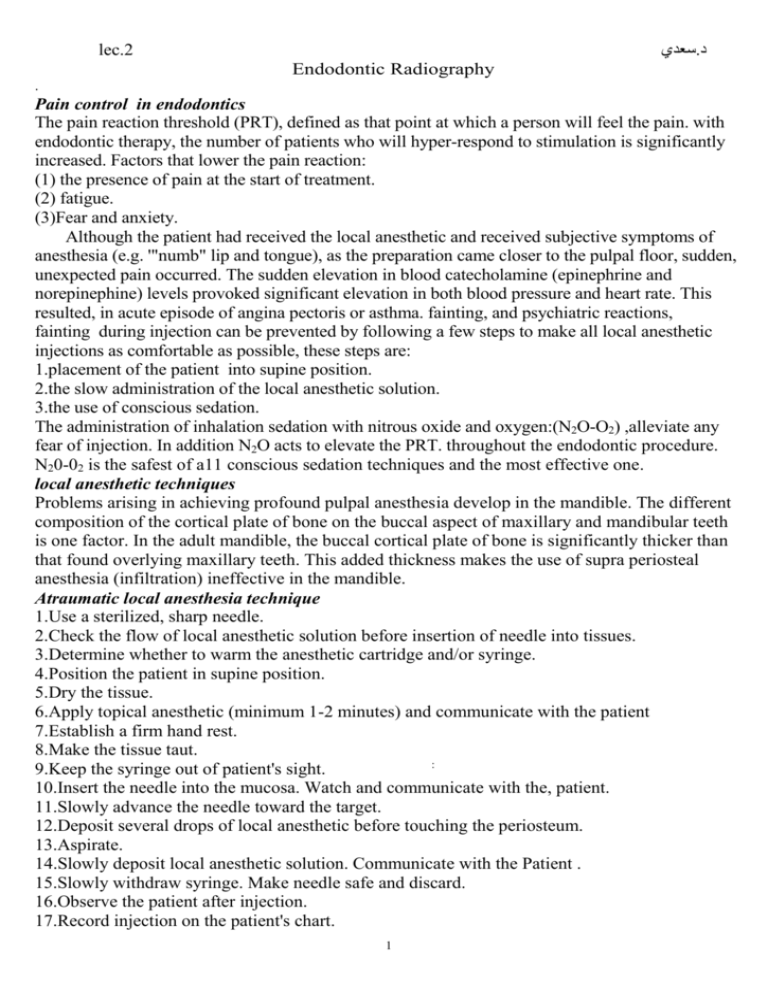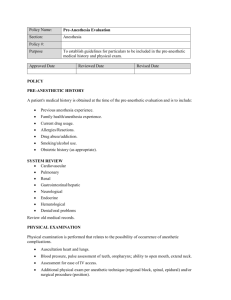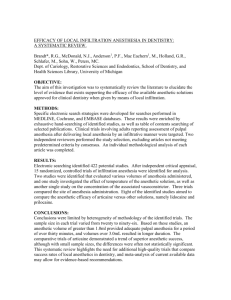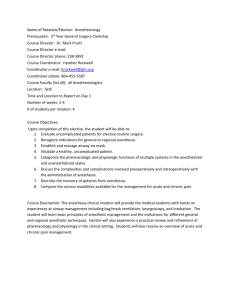Endodontic Radiography
advertisement

سعدي.د lec.2 Endodontic Radiography . Pain control in endodontics The pain reaction threshold (PRT), defined as that point at which a person will feel the pain. with endodontic therapy, the number of patients who will hyper-respond to stimulation is significantly increased. Factors that lower the pain reaction: (1) the presence of pain at the start of treatment. (2) fatigue. (3)Fear and anxiety. Although the patient had received the local anesthetic and received subjective symptoms of anesthesia (e.g. '"numb" lip and tongue), as the preparation came closer to the pulpal floor, sudden, unexpected pain occurred. The sudden elevation in blood catecholamine (epinephrine and norepinephine) levels provoked significant elevation in both blood pressure and heart rate. This resulted, in acute episode of angina pectoris or asthma. fainting, and psychiatric reactions, fainting during injection can be prevented by following a few steps to make all local anesthetic injections as comfortable as possible, these steps are: 1.placement of the patient into supine position. 2.the slow administration of the local anesthetic solution. 3.the use of conscious sedation. The administration of inhalation sedation with nitrous oxide and oxygen:(N2O-O2) ,alleviate any fear of injection. In addition N2O acts to elevate the PRT. throughout the endodontic procedure. N20-02 is the safest of a11 conscious sedation techniques and the most effective one. local anesthetic techniques Problems arising in achieving profound pulpal anesthesia develop in the mandible. The different composition of the cortical plate of bone on the buccal aspect of maxillary and mandibular teeth is one factor. In the adult mandible, the buccal cortical plate of bone is significantly thicker than that found overlying maxillary teeth. This added thickness makes the use of supra periosteal anesthesia (infiltration) ineffective in the mandible. Atraumatic local anesthesia technique 1.Use a sterilized, sharp needle. 2.Check the flow of local anesthetic solution before insertion of needle into tissues. 3.Determine whether to warm the anesthetic cartridge and/or syringe. 4.Position the patient in supine position. 5.Dry the tissue. 6.Apply topical anesthetic (minimum 1-2 minutes) and communicate with the patient 7.Establish a firm hand rest. 8.Make the tissue taut. : 9.Keep the syringe out of patient's sight. 10.Insert the needle into the mucosa. Watch and communicate with the, patient. 11.Slowly advance the needle toward the target. 12.Deposit several drops of local anesthetic before touching the periosteum. 13.Aspirate. 14.Slowly deposit local anesthetic solution. Communicate with the Patient . 15.Slowly withdraw syringe. Make needle safe and discard. 16.Observe the patient after injection. 17.Record injection on the patient's chart. 1 mandibular anesthesia One site is the lingual aspect of the mandibular ramus; the second site is the mental foramen, which is usually located between the two lower premolars. Techniques: 1.Inferior alveolar nerve block 1VNB. This technique provides pulpal anesthesia of all mandibular teeth in the quadrant, and buccal soft tissues and bone an tenor to the mental foramen and the lingual soft tissues and anterior 2/3 of the tongue. The local anesthetic solution is deposited at the mandibular foramen, the site where the inferior alveolar nerve enters the mandibular canal. 2.The Gow-Gates mandibular nerve block. The GGMNB is a true third division (V3) nerve block, providing pulpal anesthesia to all mandibular teeth in the quadrant, as well as the same soft tissue distribution as the IVNB. Also it provides sensory anesthesia of the buccal nerve as well as the mylohyoid nerve. Local anesthetic is deposited, on the lateral aspect of the neck of the mandibular condoyle. V3 has just exited the foramen ovale and with the patient's mouth maintained in a wide-open position, the nerve lies near the condylar neck. 3.The Akinosi-Vazirani Nerve Block (Closed-Mouth Technique). This technique is used in cases in which unilateral trismus is present. The patient is unable to open his mouth more than a few millimeters, preventing the administration of intraoral local anesthesia. The teeth are kept lightly in contact throughout the injection and the cheek is retracted., A long needle, either 25- or a 27-gauge is placed, with its bevel facing the midline, into the buccal fold on the side of injection at the height of the muco gingival junction of the last maxillary molar. Soft tissue on the lingual aspect of the mandible is penetrated at a site immediately adjacent to the maxillary tuberosity and the needle is advanced 25 mm, where local anesthetic is deposited. Motor paralysis usually develops before soft tissue and pulpal anesthesia.. 4.Incisive Nerve Block 1NB (Mental NB). The mental foramen is usually located between the two lower prernolars. Injection of local anesthesia at this site will provide pulpal anesthesia of the premolar, canine, and incisor teeth-Soft tissue anesthesia of the lower lip, skin of the chin, and buccal soft tissues anterior to the mental foramen is achieved. Local anesthesia is infiltrated outside the mental foramen and then, with the use of finger pressure (1 to 2 minutes), forced into the foramen and mandibular canal where the incisive nerve is located. Lingual soft tissues, including the tongue are not anesthetized. Maxillary Anesthesia Although profound pulpal anesthesia of maxillary teeth is easier to obtain, problems usually happen fallowing the administration of an infiltration injection to a central incisor, canine, or molar. The apex of the central incisor may lie under the cartilage of the nose, making infiltration less effective. Canines that have longer than usual roots may not be anesthetized when the needle is not inserted far enough. Infiltration anesthesia of maxillary molars will fail in cases where the palatal root flares greatly toward the midline of the palate. Additionally, where periapical infection is present, the success rate is injected local anesthetics is diminished. Maxillary Block Techniques 1.Posterior Superior Alveolar Nerve Block (PSANB). This technique provides reliable pulpal anesthesia to the three maxillary molars, even in the presence of infection or widely flared palatal roots. Buccal soft tissues and bone overlying this area are also anesthetized. From the needle penetration site in the buccal fold by the. second maxillary molar, the short needle is advanced to, depth of 16 mm in an inward, upward, and backward direction. 2.Middle Superior Alveolar Nerve Block (MSANB). This injection provides pulpal anesthesia to the two premolars and the mesiobuccal root of the first molar as well as the buccal soft tissues and bone overlying this area. The injection site is well above the apex of the second premolar. 2 3.Anterior Superior Alveolar Nerve Block (ASANB) (Infraorbital NB) provides pulpal anesthesia to the incisors, canine, and both premolars on as well as their overlying soft tissues. The needle is inserted into the buccal fold by the first premolar and aimed for the infraorbital foramen. Local anesthetic is deposited outside the infraorbital foramen and then forced into the foramen by the application of finger pressure for 2 minutes Supplemental Injection Technique 1.Periodontal ligament (PDL) Injection: This technique is most often used for mandibular teeth, specifically mandibular molars. A volume of 0.2 ml of local anesthetic solution is deposited inter proximally on each root of the tooth. The bevel of the needle should be placed against the root while it is advanced down into; the PDL space until resistance prevents any further penetration. Onset of clinical action is immediate, however, the duration of pulpal anesthesia is quite variable.; Two contraindications exist to administration of the PDL injections: primary teeth and the presence of periodontal infection. The presence of pocket infection in the site of needle insertion increases the risk of osteomyelitis. 2.Intraosseous (lO) Anesthesia. Local anesthetic is injected directly into the bone surrounding the root of a tooth. In the IO technique, a small perforation is made through the cortical plate of bone with a tiny dental bur, into which a needle is inserted and local anesthetic is administered. 3. Intra pulpal Anesthesia. A small needle is inserted into the pulp chamber until resistance is encountered. The local anesthetic must be injected under pressure. There will be a brief moment of intense discomfort as the injection is started, but anesthesia usually occurs immediately. Dental pain and referred pain The, diagnosis of facial pain must be approached with caution. It deserves careful and through evaluation: Fortunately, most of the symptoms that originate from oral or dental disease are easily traced to their source by a dental examination. In some cases, however, that patient may insist, that the pain is of dental origin when it is not. It is important that other cases be considered. If careful diagnosis dose not reveal the affected tooth, other teeth and related anatomic structures become suspect. . (1)pulpitis in one tooth may; cause pulpalgia (pulpal pain) in another tooth. (2)Dental pathology...may also result in sinus, eye ,ear and other head pains. When facial pain is diffused, diagnosis may be difficult and the diagnosis tests may have to be repeated to verify their results. There is a tendency for pain to appear to originate from a tooth that has had a previous painful experience rather than from its true source. Therefore, pain from a non dental. structure such as the maxillary sinuses may manifest itself as a toothache. Pulpalgia also results from disorders of the eyes or ears and even the heart. Dental radiographs allow indirect visualization of the dentition and supporting structures. Basic Radiographic Concepts 1.X rays are similar to light rays, in that both travel in a straight lines until deflected or absorbed. Deflected rays reduce image clarity. 2.The image viewed on the radiograph is similar to the shadow produced by light; that is, some X rays are prevented from reaching and exposing the film because they are absorbed by soft tissue in their path. As a result, the radiograph is a two-dimensional image of a three-dimensional structure. 3 3.The radiograph is a shadow image representing differences in densities of objects in the X rays path. 4.The size, shape, and contrast of the shadow image are subjects to many distortions, since they are dependent on the physical properties of, (a) the object through which the X rays pass. (b) the radiation source. (c) the film on which the image is recorded, as well as the relationship of the radiation source, the object, and the film. Suggestions for endodontic radiography 1.Film position. For periapical exposures the edges of the film is positioned parallel to and near the incisal or occlusal surfaces of the teeth so that the tooth apices are near the center of the film. 2.The plastic film holder facilitates standardization of a radiographic technique by aiding in film positioning and preventing movement of the film during exposure. A hemostat. may be used to hold the film. 3.Buccal object rule: The canal farther from the film (buccal) will move in the direction of the cone. 4.Rubber dam frames: plastic rubber dam frames do not interfere with taking endodontic radiographs when the rubber dam in place. Metal frames may obliterate important structures on the film. 5.An efficient method of preventing single radiograph from being misplaced is to label them with soft lead pencil prior to placing them in the developing solution. 6.Quick-processing technique. This technique is useful when visual checks are needed during preparation and filling of the root canal. 7.Mounted radiographs. All endodontic radiographs must be dated and mounted in chronological sequence to allow for immediate reference. 8.Use of film magnification. Since a great amount of information is available from radiograph that is enlarged, the use of a magnifying glass or projector his purpose is encouraged. Viewing radiographs in a darkened room, with view box being the brightest light, is also helpful in revealing diagnostic information that may not be available. Examples of endodontic information from radiographs 1.The crown and pulp space. a)Size, shape, and number of canals and their lengths. b)Accessory canals. c)Presence of pulp treatment. d)Internal or external resorption. e). Shape of the apex. d). Presence of pulp stones. 2. Periapical and periodontal areas. a)Presence of any lesion. b)Healing of periapical lesion. 3.Previous endodontic treatment. a)Spaces of voids in gutta-percha.b)Fractured instrument. c)Retrograde amalgam filling. d.Presence of any perforation. e)Short or long filling. Radiographic errors The most common, radiographic errors in the endodontics are: 1.Exposure time: Placing either too much or too little value on what is viewed on the radiograph. For many dentists this is a habitual practice. Since radiographs are merely shadows what we see in a difference in density and not always what actually exist. 2.Failure to study the radiographs. The maximum amount of information available from them is not derived. 3.Failure to obtain radiographs during treatment. The position of an instrument or the filling material could be verified. 4.Failure to take radiographs from different angles. For example, endodontic files that appear to be within the root canal system are frequently beyond the apical foramen, and obtaining radiographs from two angels might reveal the error 4







